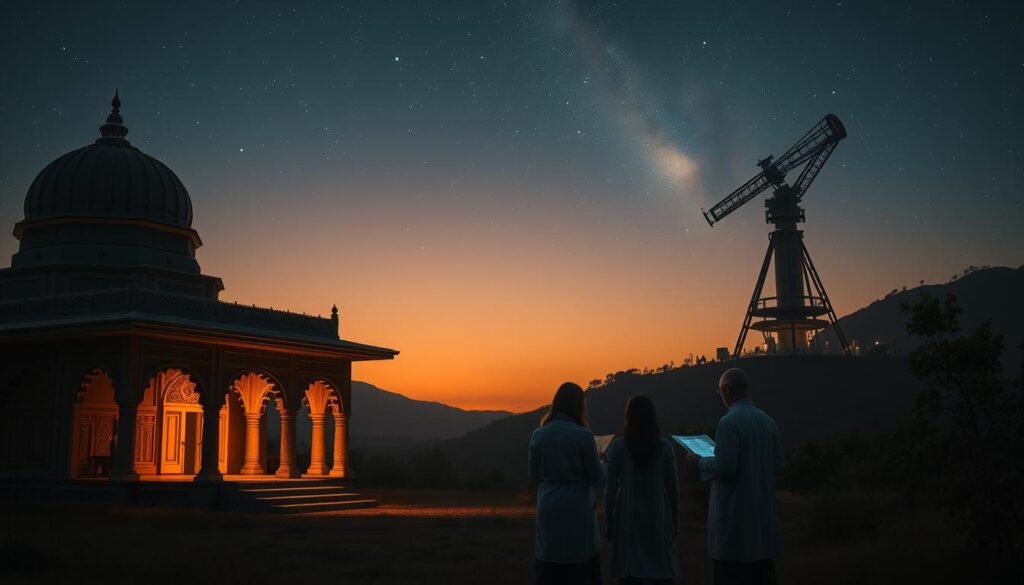Have you ever wondered why certain spiritual customs have lasted for thousands of years? Psychologist David DeSteno calls this approach “religio-prospecting” – examining traditions for insights into human wellbeing.
His research shows that engagement with spiritual communities correlates with happier, healthier lives. This isn’t about supernatural beliefs but about practical benefits that work for everyone.
Scientists are now studying how rituals and community aspects affect our brains and emotions. They’re discovering wisdom in ancient ways that can help modern people find meaning.
This fresh perspective bridges science and faith without requiring belief in gods. Both believers and atheists can benefit from understanding these time-tested practices.
Key Takeaways
- Scientists now study religious traditions for their practical benefits to human wellbeing
- Psychological research shows spiritual engagement correlates with happiness and health
- This approach focuses on rituals and community rather than supernatural beliefs
- Both religious and non-religious people can benefit from these findings
- Ancient practices may contain wisdom for modern life challenges
- The community aspect of religion appears particularly important for human flourishing
- This research represents a significant shift in how we understand spiritual traditions
Why Scientists Are Now Studying Ancient Faith
What if science could learn from faith traditions without needing to believe in the supernatural? This is exactly what’s happening today. Researchers are exploring spiritual customs for their practical benefits to human wellbeing.
For much of modern history, science viewed religion with skepticism. Many saw it as superstition rather than something worth serious study. That perspective is changing dramatically.
Today’s researchers approach spiritual traditions with fresh curiosity. They’re discovering that these practices contain wisdom about human psychology and community bonding. This shift represents a new chapter in understanding what helps people thrive.
The Shift from Superstition to Science
Scientists once dismissed religious practices as primitive thinking. Now they recognize these traditions have stood the test of time for good reason. The focus has moved from supernatural claims to observable benefits.
Researchers examine how rituals affect your brain and emotions. They study how community engagement impacts your health and happiness. This evidence-based approach reveals why certain customs persist across generations.
This scientific humility acknowledges that ancient wisdom might contain valuable insights. Just as traditional medicines led to modern pharmaceuticals, spiritual practices might offer psychological benefits we’re only beginning to understand.
David DeSteno and the Concept of “Religio-Prospecting”
Psychologist David DeSteno pioneered this fresh approach. His background in both religious studies and psychology gives him unique perspective. He calls his method “religio-prospecting.”
“Religio-prospecting examines traditional practices to discover what benefits they might offer, similar to how pharmaceutical companies studied traditional medicines.”
This concept doesn’t require belief in gods or afterlife. Instead, it focuses on how engagement with spiritual communities improves your life. The research shows participation itself brings measurable benefits.
Virtues emphasized by religions—gratitude, compassion, connection—prove valuable for everyone. Both believers and non-believers can apply these insights. This research builds bridges between scientific and spiritual communities.
Your participation in meaningful traditions can enhance your wellbeing regardless of your beliefs. The practices themselves, refined over millennia, contain wisdom about human flourishing that science is only beginning to appreciate.
How Your Beliefs Can Literally Make You Healthier
Science now reveals how deeply your worldview impacts your physical wellbeing. Multiple studies show consistent connections between spiritual engagement and better health outcomes.
Researchers track everything from blood pressure to longevity markers. The results might surprise you with their consistency across different populations.
The Data on Faith, Happiness, and Longevity
Large-scale studies demonstrate remarkable patterns. People who regularly participate in spiritual communities show significant health advantages.
They experience lower rates of depression and anxiety. Their physical health markers often outperform non-participants.
One comprehensive review analyzed data spanning decades. It found religious engagement correlates with longer life expectancy.
The effect remains significant even when controlling for other factors. This suggests something unique about these practices benefits your body.
Reducing Anxiety and Decision Fatigue
Your brain’s alarm centers respond differently when you have faith. Neuroscientific studies show reduced activity in anxiety-related regions.
This calming effect resembles how anti-anxiety medications work. It helps you face difficult decisions with greater clarity.
Psychologist Andi Clements studies this “surrender response.” Her research shows reduced addiction and depression rates among people who practice trust.
This approach prevents you from becoming a “maximizer” who over-analyzes every choice. Instead, you make good decisions without paralyzing over-analysis.
Religious belief helps reduce decision fatigue in practical ways. You can make your best decision then trust that things will work out.
This reduced anxiety contributes directly to better health outcomes. Your body benefits from lower stress levels over time.
The practical benefits extend far beyond supernatural claims. They touch your daily experience and physical wellbeing in measurable ways.
The Surprising Power of Rituals and Community
Have you noticed how gathering with others can transform your mood? Shared experiences create bonds that last for years. This connection forms the heart of many spiritual traditions.
These gatherings combat loneliness in our modern world. They provide a sense of belonging that many people crave. This isn’t just about faith—it’s about human connection.
Combating the Modern “Loneliness Epidemic”
Religious communities offer powerful social connections. They bring people together regularly. This consistent contact builds strong relationships.
Research shows these groups fight isolation effectively. Miguel Farias studied synchronized rituals in congregations. His work reveals how collective behaviors create bonding.
Even simple actions like standing or kneeling together matter. These shared movements release endorphins in your brain. They create feelings of warmth and connection.
Why Group Singing and Prayer Feel So Good
Group activities trigger neurological responses. Singing hymns or praying together releases feel-good chemicals. Your body responds to these synchronized actions.
This process works like chemical “grooming” for large groups. Primates bond through physical touch. Humans bond through shared rituals.
These practices evolved over thousands of years. They helped our ancestors form cohesive communities. Today, they still provide emotional benefits.
You experience reduced stress and increased wellbeing. The group becomes part of your support system. This connection enhances your quality of life.
Meditation’s Original Purpose: Boosting Compassion
What if your meditation practice could transform not just your inner peace but your outer actions? Modern science reveals that meditation’s deepest benefits extend far beyond personal relaxation.
The original purpose of these contemplative practices was reducing suffering for yourself and others. This compassionate approach formed the heart of many spiritual traditions across cultures.
Beyond Relaxation: The Science of Spontaneous Kindness
Laboratory experiments show meditation dramatically increases helping behavior. In one study, people who meditated for eight weeks became three times more likely to help someone in pain.
Researchers created a realistic waiting room scenario. An actor on crutches pretended to struggle while others watched. Only 15% of non-meditators offered help.
Among those who completed meditation training, 50% spontaneously assisted the person. This demonstrates how meditation changes your automatic responses to suffering.
The practice also reduces aggressive reactions when people feel insulted. Meditators show less desire for vengeance and more emotional balance.
“These findings suggest meditation doesn’t just change how you feel—it changes how you act when no one is watching.”
Replicating the Lab Experiments on Helping Behavior
Multiple studies confirm meditation’s impact on spontaneous compassion. The effects appear in real-world situations, not just self-reported attitudes.
Your brain changes through regular practice. Neurological scans show increased activity in regions associated with empathy and emotional regulation.
This research validates wisdom that’s been practiced for thousands of years. The benefits work regardless of your religious beliefs or background.
Here’s how meditation creates these changes:
- Strengthens neural pathways for empathy and compassion
- Reduces automatic stress responses to challenging situations
- Creates space between stimulus and response for wiser choices
- Develops greater awareness of others’ emotional states
These practices offer practical benefits for your daily life. You might find yourself more patient in traffic or more understanding with difficult people.
The beauty lies in their accessibility. You can incorporate meditation into your routine without adopting specific beliefs. The practice itself brings measurable changes to how you move through the world.
This evidence bridges modern science and timeless wisdom. It shows how certain practices developed over centuries contain profound insights into human flourishing.
New Theories About Ancient Religious Practices and Their Origins
You might have heard some common explanations for why spiritual traditions developed throughout human history. Many of these ideas are now being questioned by fresh discoveries.

Moving Beyond “Big Gods” and “False Agency”
The “Big Gods” idea suggested that belief in powerful, moralizing deities helped large communities cooperate. This theory claimed people behaved better when they thought gods were watching.
Recent evidence challenges this view. Archaeological finds show that large human groups existed long before these concepts of moralizing gods appeared. Communities successfully organized themselves without this specific form of belief.
Another popular explanation, the “False Agency” hypothesis, proposed that religion emerged from cognitive errors. It suggested our ancestors mistakenly attributed agency to natural events.
This idea doesn’t hold up under scrutiny either. Studies of contemporary hunter-gatherer groups show they’re actually quite accurate at distinguishing real threats from false ones. They don’t show neurotic superstition but practical discernment.
Why Older Evolutionary Explanations Are Falling Short
Many traditional theories were based on the idea that people attribute agency in childlike ways. They assumed our brains make simple mistakes when interpreting the world.
Modern research reveals this isn’t how cognition works. Both our fast and slow thinking systems would naturally correct false agency attributions over time. Our brains aren’t prone to persistent errors of this nature.
Theories about modular cognitive systems also face limitations. They don’t adequately explain why spiritual traditions have remained so universal across cultures and time periods.
These older explanations struggle to account for the deep meaning people find in these practices. They don’t capture the emotional and community aspects that make traditions endure for thousands of years.
There’s growing recognition that we need better theories. These new approaches must fit the archaeological evidence more accurately. They should also respect the complexity of human experience throughout history.
Researchers are now developing more plausible explanations. These fresh perspectives better account for why spiritual practices became such a fundamental part of human life across diverse cultures.
The Leading Contender: The “Trance” Hypothesis
Imagine discovering you could journey beyond ordinary reality through rhythm and movement. This powerful experience might explain how spiritual traditions first began among our ancestors.
Oxford anthropologist Robin Dunbar presents a compelling idea called the “Trance Hypothesis.” His research suggests early humans accidentally discovered methods to alter consciousness.
Robin Dunbar and the Role of Altered States
Professor Dunbar brings impressive credentials to this exploration. As an Oxford scholar, he leads a multidisciplinary team studying human behavior across time.
His work emerged from meetings of the International Society for Science and Religion. This collaborative approach brings together experts from cognitive science, psychology, sociology, and theology.
Dunbar’s hypothesis differs from animal awe experiences. While animals might feel wonder at nature, humans developed intentional methods to shift consciousness. This distinction matters for understanding our unique spiritual capacities.
Dancing, Drumming, and Ecstatic Experiences
Early communities discovered various techniques to enter trance states. Rhythmic dancing created powerful group synchronization. Drumming patterns altered brain wave activity.
Chanting and vocalizations produced vibrational effects throughout the body. Feasting and fasting also helped induce altered states of awareness.
These practices allowed exploration beyond ordinary reality. People began perceiving multidimensional spiritual worlds. They developed animistic rituals recognizing spirit in all things.
Shamanistic skills emerged from these explorations. Certain individuals learned to navigate these altered states skillfully. They brought back knowledge and healing for their communities.
This interdisciplinary research helps explain why spiritual traditions became universal across human cultures. The trance hypothesis offers a plausible account of how it all began.
These discoveries set the stage for understanding the adaptive benefits that would follow. The next section explores how these practices created powerful social bonding through neurochemical mechanisms.
The Neurochemical Glue: Endorphins and Social Bonding
Your brain releases special chemicals during synchronized activities that bond people together. This biological process explains why group rituals create such powerful connections. Science now understands how these neurochemicals work as social glue.
How Rituals Act as Chemical “Grooming” for Large Groups
Synchronized rituals trigger endorphin release in participants. These natural opioid hormones ease tension throughout your body. They promote feelings of warmth and connection with others.
Endorphins create what scientists call “chemical grooming.” This process allows human groups to bond efficiently. Unlike primates limited by physical grooming time, humans can form much larger communities.
Research shows even modest synchronized activities create bonding. Simple actions like standing together or breathing in rhythm matter. These shared movements release feel-good chemicals in your brain.
The concept of chemical grooming explains prosocial behavior in groups. It helps people cooperate and support each other. This mechanism works across different traditions and settings.
From Hunter-Gatherer Ceremonies to Modern Hymn Singing
This bonding mechanism has ancient roots. Early humans discovered rhythmic ceremonies created group cohesion. Dancing, drumming, and chanting released endorphins naturally.
Modern religious practices continue this tradition. Hymn singing in churches triggers the same neurochemical response. The continuity spans thousands of years of human experience.
Studies measure endorphin release in various settings. Researchers found elevated levels during group rituals. This evidence supports the evolutionary advantage of these practices.
The mechanism works regardless of specific beliefs. It’s about the shared experience rather than doctrine. This explains why different traditions use similar rhythmic elements.
Your participation in these activities creates biological bonding. The endorphin release makes you feel connected to others. This neurochemical process enhances your sense of community and belonging.
What Archaeology Tells Us About Prehistoric Rituals
Have you ever considered what ancient burial sites reveal about early human beliefs? Archaeological discoveries provide fascinating glimpses into how our ancestors understood life and death. These findings show sophisticated spiritual practices dating back hundreds of thousands of years.
Interpreting Grave Goods and Cave Art
Burial sites from over 250,000 years ago contain carefully placed grave goods. Beaded necklaces and pendants accompany human remains. These items suggest early concepts of an afterlife.
Our ancestors might have believed these objects traveled with the deceased. This practice indicates complex thinking about what happens after death. The consistency across different regions shows shared spiritual ideas.
Cave paintings provide another window into early consciousness. Many artworks depict hybrid human-animal figures. These images likely represent altered states of experience.
The cave environments themselves enhanced these spiritual encounters. Natural acoustics amplified chanting and drumming. Flickering torchlight created moving shadows on the walls.
These sensory elements combined to create powerful rituals. Participants could enter different states of awareness. The cave became a portal to other realms of existence.
Evidence of Feasting and Synchronized Activities
Animal remains tell stories of massive communal gatherings. Analysis shows single wild bulls could feed up to 1,000 people. These feasts brought communities together in celebration.
The scale of these events indicates sophisticated organization. People coordinated hunting, preparation, and distribution. This cooperation strengthened social bonds through shared experience.
Archaeologists find evidence of synchronized movements in ritual spaces. Wear patterns on floors show repeated group activities. These might include dancing, chanting, or processions.
Some burial sites appear within living spaces. This placement suggests ongoing connection with ancestors. The dead remained part of the community’s daily life.
Estimating ritual frequency presents challenges for researchers. They examine wear patterns, artifact distributions, and site layouts. Each clue helps reconstruct how often ceremonies occurred.
Interpreting these ancient practices requires careful consideration. We must avoid projecting modern assumptions onto past cultures. The evidence suggests rich spiritual traditions that gave meaning to human existence.
Harvey Whitehouse and the Theory of Ritual Frequency
Have you ever noticed how some group activities feel casual while others create deep bonds? Anthropologist Harvey Whitehouse developed a fascinating theory about why different rituals create different levels of connection. His research shows that how often you perform rituals matters just as much as what you do.
Whitehouse’s work reveals two distinct patterns in human behavior. High-frequency rituals happen regularly, like weekly services. High-arousal rituals occur rarely but with intense emotion. Each type shapes your group identity in unique ways.
High-Frequency Rituals vs. High-Arousal Rituals
High-frequency rituals build identity through repetition. Think of weekly religious services or daily prayers. These regular practices create comfortable familiarity. They help you feel part of something larger than yourself.
These traditions often feature clear hierarchies. Leaders guide participants through established patterns. The repetition makes complex ideas easier to remember and share.
High-arousal rituals work differently. They involve intense, emotional experiences that happen infrequently. Think initiation ceremonies or pilgrimage events. These create what psychologists call “identity fusion.”
This fusion makes you feel deeply connected to others who shared the experience. It creates stronger bonds than regular meetings. The intensity leaves lasting impressions on your memory and sense of self.
How Rituals Forge Identity and Willingness to Sacrifice
Whitehouse studied how these rituals affect behavior. His team examined military groups and football fans. They found fascinating patterns in willingness to sacrifice for the group.
High-frequency rituals create solid group identity. You know who belongs and who doesn’t. But high-arousal rituals create something deeper—identity fusion.
“Identity fusion makes people feel so connected to their group that they’re willing to make extraordinary sacrifices for other members.”
This explains why some groups show remarkable loyalty. People who share intense experiences feel fundamentally connected. They’ll protect each other in ways that surprise outsiders.
The psychological mechanisms behind this are powerful. Intense rituals create shared emotional states. Your brain processes these as deeply meaningful events.
These experiences become part of your personal story. They shape how you see yourself in relation to others. The bonds formed during high-arousal rituals can last a lifetime.
Whitehouse’s research helps explain many social phenomena. From military cohesion to sports fan loyalty, these patterns appear across human cultures. The frequency and intensity of shared experiences shape our deepest connections.
Why Difficult and Painful Rituals Are So Effective
Why do some of the most challenging group experiences create the strongest bonds between people? Research shows that shared suffering creates deeper connections than shared joy. This counterintuitive finding explains why many traditions include difficult elements.
The Psychology of Shared Suffering in Papua New Guinea
Anthropologist Harvey Whitehouse studied initiation rites in Papua New Guinea. His research revealed how painful ceremonies created incredibly tight military units. Young men underwent difficult tests together.
These challenging experiences broke down normal social boundaries. Participants developed what psychologists call “identity fusion.” They felt so connected that they’d sacrifice for each other.
Whitehouse found this bonding lasts for years. The shared hardship became part of their personal identity. This explains why military and ritual groups maintain strong loyalty.
From Military Training to Football Fandom
Modern studies show this pattern extends beyond traditional rituals. Football fans who suffer together bond more strongly. Losing games or enduring bad weather creates deeper connections.
Researchers found that winning teams don’t create the same bonding. It’s the shared struggle that matters most. This surprised many sports psychologists.
Military training intentionally uses dysphoric experiences. Boot camp breaks down individual identity. It builds unit cohesion through shared challenge.
The psychological mechanism is fascinating. Difficult experiences blur the line between self and others. Your brain processes shared suffering as collective identity.
Fraternity hazing shows similar effects. Though controversial, these rituals create strong group bonds. Members feel deeply connected to their community.
This research helps explain many social phenomena. From ancient initiations to modern fandom, shared hardship creates unbreakable bonds. The willingness to sacrifice correlates with difficult shared experiences.
The Evolution from Animism to Doctrinal Religion
What happens when small tribal communities grow into large agricultural civilizations? This transition transformed not just how people lived but how they understood the spiritual world. The shift from foraging to farming created entirely new social structures that required different forms of bonding and belief systems.
The Impact of Settled Agriculture and Larger Societies
When humans began farming around 12,000 years ago, everything changed. Small mobile groups settled into permanent villages. These grew into towns and eventually cities with thousands of residents.
This created new social challenges. In small foraging bands, everyone knew each other personally. Trust came from face-to-face relationships and shared experiences.
Large agricultural societies needed different bonding mechanisms. They developed formal institutions and written codes. Religious systems evolved to meet these new needs.
Small groups used intense, emotional rituals for bonding. These high-arousal experiences created deep connections between members. But they didn’t scale well to large populations.
Large societies developed high-frequency rituals instead. Regular weekly gatherings replaced rare intense ceremonies. This created consistent group identity across thousands of people.
The Rise of “High Gods” and Moralizing Supernatural Agents
As societies grew larger, new types of deities emerged. These “High Gods” possessed omniscient qualities. They could see everything and judge moral behavior.
This development served important social functions. In small groups, social pressure maintained order. Everyone watched everyone else’s behavior.
Large societies needed supernatural surveillance. Moralizing gods ensured cooperation between strangers. They helped maintain social order beyond face-to-face relationships.
Archaeological evidence shows this transition clearly. Early agricultural sites reveal temple structures and ritual spaces. These indicate organized religious systems serving large communities.
The nature of religious experience changed during this period. Personal spiritual encounters gave way to standardized doctrines. Written texts preserved beliefs across generations.
This shift offered cultural evolutionary advantages. Doctrinal systems could spread across vast territories. They helped integrate diverse groups into cohesive societies.
Different social structures required different religious forms. Small groups needed intense bonding experiences. Large societies needed moral regulation and group identity maintenance.
This evolutionary perspective helps explain religious diversity. Various forms developed to meet specific social needs. Each offered adaptive advantages for particular contexts.
Understanding this history gives you insight into modern belief systems. It shows how human creativity addressed fundamental social challenges across millennia.
Your Brain is Wired for Religious Intuition
Have you ever felt an unseen presence when you thought you were alone? This experience isn’t supernatural—it’s how your brain naturally works. Scientists discover that human minds come pre-wired with spiritual intuitions that appear across all cultures.
These natural predisitions explain why certain ideas feel instinctively true to you. They form the foundation that cultural traditions later build upon. Your mind creates these experiences without any formal teaching.
Why You Feel Watched or Sense a Designer
That feeling of being watched when doing something wrong? It’s a universal human experience. Your brain has detection systems that alert you to potential observers.
This mechanism helped our ancestors navigate social relationships. It ensured they considered how their actions affected others. Today, this same system creates intuitive feelings of supernatural observation.
Natural complexity also triggers designer intuition in your mind. When you see intricate patterns in nature, your brain instinctively looks for intentional creation. This tendency explains why design arguments appear across human history.
The Universal Intuition of an Afterlife
Belief in continuation after death appears in virtually all human societies. This isn’t about specific religious doctrines but a fundamental intuition. Your mind naturally resists the idea of complete cessation.
Psychological research shows this intuition begins in childhood. Children across cultures demonstrate innate afterlife beliefs. They assume consciousness continues even when the body stops functioning.
This predisposition helps explain why afterlife concepts develop independently worldwide. Cultural traditions elaborate on this basic intuition. They create detailed visions of what comes next.
These intuitions persist even in secular people. Atheists often report feeling watched or sensing meaning in patterns. The basic wiring remains active regardless of conscious beliefs.
Cultural systems build upon these natural foundations. They develop the raw intuitions into formal doctrines and practices. This explains why different religions share certain core concepts despite geographical separation.
Your brain provides the basic template. Culture provides the specific content. This collaboration between biology and tradition creates the rich diversity of spiritual expression.
Evolutionary psychology suggests these intuitions offered adaptive advantages. They promoted social cohesion and cooperation within groups. The tendencies that helped our ancestors survive now shape your spiritual experiences.
Everyone possesses these religious predispositions to some degree. They represent fundamental aspects of how human consciousness operates. Your mind naturally reaches toward concepts larger than everyday experience.
Separating Belief from Experience
What if your physical actions actually shaped your spiritual understanding more than your beliefs? This perspective flips traditional thinking about how spiritual traditions develop. Your experiences often come first, with explanations following later.
How Practices Often Precede and Shape Doctrine
Many spiritual customs began as actions without formal explanations. People performed rituals for generations before theologians developed complex doctrines. The doing came before the explaining.
Your kneeling posture during prayer provides a perfect example. This physical position emerged naturally across different cultures. Only later did thinkers develop theological reasons for why you should kneel.
Pilgrimage journeys show the same pattern. People traveled to sacred sites for centuries. Theological meanings attached to these journeys developed over time.
This pattern appears across many traditions. Physical practices create the foundation. Intellectual systems build upon this experiential base.
“Ritual actions generate meanings that doctrines later attempt to capture in words.”
Your participation in these activities shapes your understanding. The experience itself teaches you something words cannot fully express. This explains why different people find similar meaning in the same practices.
The Dreamlike Quality of Ancient Myths
Many sacred stories possess a dreamlike quality that feels familiar. They blend reality and fantasy in ways that resemble your nighttime experiences. This isn’t accidental—dreams likely inspired these narratives.
Your brain naturally creates stories during sleep. Early humans probably experienced vivid dreams that felt spiritually significant. These nighttime visions may have formed the basis for many myths.
Mammalian brains all experience dreaming. This universal capacity suggests dreams could have influenced spiritual development across human groups. The imagery feels powerful and memorable.
Myths often feature transformations and impossible events. People change into animals or objects. These elements mirror the fluid logic of your dreams.
The connection between dreams and myths helps explain their enduring power. They tap into deep psychological processes that feel intuitively meaningful. This dreamlike quality makes stories memorable across generations.
Your mind naturally seeks patterns and meanings. Dreams provide rich material for this meaning-making process. Cultural traditions then refine these raw materials into structured narratives.
This perspective helps you understand why myths feel both strange and familiar. They emerge from mental processes you experience every night. The boundary between waking and dreaming reality becomes beautifully blurred.
Recognizing this dream connection doesn’t reduce myths’ significance. Instead, it reveals how deeply they’re rooted in human experience. Your nighttime journeys contribute to daytime meaning.
What Ancient Practices Can Teach Us Today
Have you ever considered how timeless wisdom might improve your daily existence? These enduring methods offer practical benefits that transcend supernatural beliefs. They provide tools for enhancing your wellbeing regardless of your spiritual perspective.
Modern research validates what many cultures understood intuitively. Certain activities consistently improve mental and physical health. You can incorporate these elements into your routine without adopting specific doctrines.
Cultivating Gratitude and Compassion in Your Own Life
Meditation increases compassion regardless of your belief system. Studies show regular practice makes you more likely to help others spontaneously. This effect appears in real-world situations, not just laboratory settings.
Gratitude practices significantly improve perseverance and goal achievement. Keeping a simple thankfulness journal strengthens your resilience. You notice positive aspects even during challenging periods.
These methods work through measurable neurological changes. Your brain develops stronger pathways for empathy and emotional regulation. The benefits accumulate over time through consistent practice.
“The most profound wisdom often appears in the simplest daily practices—how we pay attention, how we express thankfulness, how we connect with others.”
You can start with small, manageable steps. Try five minutes of mindful breathing each morning. Write down one thing you appreciate before bed.
Compassion grows through regular attention to others’ wellbeing. Simple acts of kindness create positive feedback loops. Your actions influence your emotional state in powerful ways.
Finding Connection in a Secular World
Community rituals effectively combat modern loneliness. Synchronized activities release endorphins that create bonding. This biological process works regardless of theological content.
Religious engagement reduces anxiety and decision fatigue. The practices themselves provide structure and comfort. You can adapt these elements to secular contexts.
Look for groups that share your values and interests. Book clubs, volunteer organizations, or hobby groups provide community. Regular gatherings create the rhythm that fosters connection.
Shared meals mirror ancient feasting traditions. Cooking and eating together builds relationships naturally. These simple acts create belonging through shared experience.
Group movement activities trigger neurochemical bonding. Dance classes, hiking groups, or team sports offer modern alternatives. Your body responds to synchronized action with feelings of connection.
These approaches demonstrate how wisdom endures across generations. The forms adapt while the core benefits remain constant. You can draw from this rich heritage without specific theological commitments.
The measurable effects on wellbeing make these practices valuable for everyone. Reduced stress, increased happiness, and stronger social bonds await. Your life becomes richer through these time-tested methods.
Science and Religion: Not Enemies, but Partners
What if two powerful forces could work together instead of fighting? Science and faith traditions often seem like opponents. But they’re actually natural partners in exploring human experience.

This collaboration brings together diverse experts. Cognitive scientists study how your brain processes spiritual experiences. Psychologists examine emotional benefits of group rituals.
Sociologists analyze how communities form around shared values. Theologians contribute historical context about various traditions. Philosophers help frame the big questions about meaning and purpose.
Building a Respectful Conversation for Human Flourishing
This partnership focuses on practical benefits rather than supernatural debates. Researchers explore how spiritual practices improve your quality of life. They study measurable effects on health and happiness.
The conversation remains respectful across different perspectives. Scientists acknowledge wisdom in time-tested traditions. Religious leaders appreciate evidence-based approaches to human wellbeing.
“When science and spirituality work together, they create a more complete picture of human experience—one that honors both empirical evidence and profound meaning.”
This approach benefits everyone regardless of personal beliefs. You can appreciate the practical value of meditation without adopting specific doctrines. Community rituals offer connection even if you don’t share theological views.
The Future of Interdisciplinary Research
Collaborative studies will continue revealing fascinating insights. Future research might explore how different traditions affect brain chemistry. Teams could compare rituals across various faith communities.
Long-term studies will track how spiritual engagement impacts health over decades. Researchers might develop new practices combining ancient wisdom with modern understanding.
This partnership promises exciting discoveries about human potential. Both fields contribute unique strengths to understanding how people thrive. Science provides rigorous methods for testing ideas.
Spiritual traditions offer centuries of accumulated wisdom about human needs. Together, they create a richer understanding of what helps communities flourish.
The future looks bright for this collaborative approach. As more experts work across traditional boundaries, everyone benefits from their combined insights.
Conclusion
You have journeyed through the remarkable connections between spiritual traditions and human wellbeing. Science now reveals how these customs contain deep wisdom about our needs for connection and meaning.
The trance hypothesis shows how altered states helped early communities bond. Ritual frequency theory explains why shared experiences create such strong group identity. Neurochemical research demonstrates how synchronized activities release bonding chemicals in your brain.
These insights benefit everyone, regardless of personal beliefs. The practices themselves offer practical value for modern life. They provide structure, reduce anxiety, and create community.
This research builds bridges between science and spirituality. It honors both evidence-based approaches and timeless wisdom. You can draw from this rich heritage to enhance your own wellbeing.
The enduring power of these traditions across thousands of years speaks to their profound value. They address fundamental human needs that remain relevant today.






